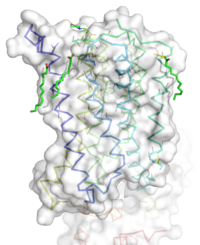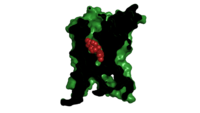Sandbox Reserved 1160
From Proteopedia
(Difference between revisions)
| Line 9: | Line 9: | ||
The mGlu family of receptors was the first of the Class C [[GPCR]] to be extensively studied<ref name="Wu" />. The first regions of the protein crystallized and studied were the Venus Fly Trap domain and the cystiene -rich domain on the extracellular region of the receptor<ref name="Dore" />.The Venus Flytrap domain is a large extracellular domain that will selectively bind to glutamate<ref name="Wu" />. The CRD is a somewhat smaller domain composed of many B sheets and cystiene residues <ref name="Wu" />. The CRD acts as a signal mediator between the Venus Flytrap domain and the TMD of mGlu5, by linking to each domain with disulfide bonds<ref name="Wu" />. The hydrophobic nature and flexibility of the transmembrane domain made it difficult to crystallize. Recently, the human metabotropic glutamate receptor 5 transmembrane domain (TMD) was crystallized and a structure elucidated<ref name="Dore" />. Several modifications made to the TMD for successful crystallization. The protein was thermostabilized and flexible domains were removed<ref name="Dore" />. In total residue 2-568 and residues 837-1153 were excised from the structure. Also, a T4 -<scene name='72/721531/Protien_lys/1'>Lysozyme</scene> was inserted into intracellular loop 2 to add stability<ref name="Dore" />. | The mGlu family of receptors was the first of the Class C [[GPCR]] to be extensively studied<ref name="Wu" />. The first regions of the protein crystallized and studied were the Venus Fly Trap domain and the cystiene -rich domain on the extracellular region of the receptor<ref name="Dore" />.The Venus Flytrap domain is a large extracellular domain that will selectively bind to glutamate<ref name="Wu" />. The CRD is a somewhat smaller domain composed of many B sheets and cystiene residues <ref name="Wu" />. The CRD acts as a signal mediator between the Venus Flytrap domain and the TMD of mGlu5, by linking to each domain with disulfide bonds<ref name="Wu" />. The hydrophobic nature and flexibility of the transmembrane domain made it difficult to crystallize. Recently, the human metabotropic glutamate receptor 5 transmembrane domain (TMD) was crystallized and a structure elucidated<ref name="Dore" />. Several modifications made to the TMD for successful crystallization. The protein was thermostabilized and flexible domains were removed<ref name="Dore" />. In total residue 2-568 and residues 837-1153 were excised from the structure. Also, a T4 -<scene name='72/721531/Protien_lys/1'>Lysozyme</scene> was inserted into intracellular loop 2 to add stability<ref name="Dore" />. | ||
== Structure== | == Structure== | ||
| - | [[Image:STR.png|200 px|left|thumb|'''Figure 1''': Overall Structure of the mGlu5 TMD. The polar heads on the Oliec acids orient the image with the top oriented extracellularly, the middle portion inserted into the membrane, and the lower portion oriented intracellularly. The white exterior represents the surface of the protien, and the multicolored | + | [[Image:STR.png|200 px|left|thumb|'''Figure 1''': Overall Structure of the mGlu5 TMD. The polar heads on the Oliec acids orient the image with the top oriented extracellularly, the middle portion inserted into the membrane, and the lower portion oriented intracellularly. The white exterior represents the surface of the protien, and the multicolored lines interior to the surface represent the backbones 7 transmembrane alpha helices. ]] |
=== Overview === | === Overview === | ||
The mGlu5 TMD contains 7 <scene name='72/721531/Protien_7_helices/3'> alpha helices</scene> that spans the membrane. The protein was crystallized with Oleic acid and MES. On the superior portion of the protein there are several critical extracellular loops. The binding pocket can be found near the middle of the protein. Inserted into the biding pocket is the negative allosteric modulator [http://www.en.wikipedia.org/wiki/Mavoglurant mavoglurant]. It is important to note that the TMD as illustrated is in an inactive conformation. On the intracellular portion of the protein there exist several ionic locks whose positions will determine the activity of the protein. | The mGlu5 TMD contains 7 <scene name='72/721531/Protien_7_helices/3'> alpha helices</scene> that spans the membrane. The protein was crystallized with Oleic acid and MES. On the superior portion of the protein there are several critical extracellular loops. The binding pocket can be found near the middle of the protein. Inserted into the biding pocket is the negative allosteric modulator [http://www.en.wikipedia.org/wiki/Mavoglurant mavoglurant]. It is important to note that the TMD as illustrated is in an inactive conformation. On the intracellular portion of the protein there exist several ionic locks whose positions will determine the activity of the protein. | ||
| Line 35: | Line 35: | ||
== Disease == | == Disease == | ||
=== Fragile X === | === Fragile X === | ||
| - | Fragile X syndrome is the most common genetic cause of mental disability, and is a member of the Autism spectrum disorder family<ref name="Bailey" />. The severity of intellectual disability can vary from patient to patient, but symptoms stem from a misregulation of the mGlu1 and MGlu5 pathways<ref name="Bailey" />. | + | Fragile X syndrome is the most common genetic cause of mental disability, and is a member of the Autism spectrum disorder family<ref name="Bailey" />. The severity of intellectual disability can vary from patient to patient, but symptoms commonly stem from a misregulation of the mGlu1 and MGlu5 pathways<ref name="Bailey" />. Misregulation of these pathways leads to over potentiation in neural cells. Mavoglurant and other allosteric regulators like [http://www.en.wikipedia.org/wiki/Fenobam fenobam] have shown promise in treating Fragile X. One positive characteristic of ligands that target the TMD of mGlu5 is they tend to be more specific, thus interacting less with nonspecific brain proteins<ref name="Feng" />. Mavoglurant down regulates glutamate signaling in an attempt to decrease potentiation. Unfortunately, recent Phase 2 clinical trials have proven mavoglurant ineffective <ref name="Bailey" />. However, modulators of mGlu5 TMD are still being investigated as treatment for to Parkinson's, Alzheimer's disease, and various addictions<ref name="Niswender" />. |
Revision as of 18:34, 10 April 2016
Human metabotropic glutamate receptor 5 transmembrane domain
| |||||||||||


